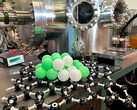According to new research, biomethane is emerging as a game-changer in ammonia production. It offers a way to turn what's typically a major carbon emitter into a carbon-neutral process.
In a study published in One Earth, environmental engineer Aurelian Istrate shows how adding biomethane to ammonia production could drastically reduce environmental impact. This is especially important because ammonia is a key ingredient in synthetic fertilizers, vital for feeding billions of people worldwide.
Traditionally, ammonia is made by extracting hydrogen from natural gas, a process that releases a lot of carbon into the atmosphere. While renewable energy for electrolysis is an option, it's expensive and not widely adopted.
Istrate's idea focuses on using biomethane made from food waste and agricultural leftovers. This renewable gas is chemically similar to natural gas (CH₄), but the big difference is that it operates in a closed carbon cycle. The CO₂ released during production was initially captured through photosynthesis as the plants grew, making it much more sustainable.
The study looks at three ammonia production methods: conventional, electrolysis, and biomethane-based. The results suggest that combining biomethane with carbon capture and storage (CCS) technology could produce carbon-neutral ammonia. Even with a mix of 44 percent biomethane and 56 percent natural gas paired with CCS, the process could reach carbon neutrality.
What's especially interesting is that this method can be used without new technology. CO₂ separation is already part of biomethane and ammonia production, so the infrastructure is already in place. That makes biomethane a practical option for reducing emissions in agriculture without disrupting the supply of fertilizers.
Source(s)
InterestingEngineering (in English) & PhysOrg (in English)














